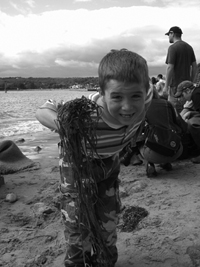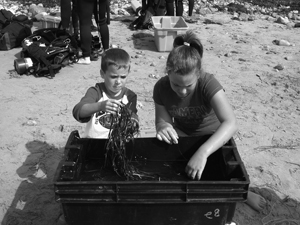
Bringing Eelgrass Back
by Andrea Cohen, MIT Sea GrantOn a sunny Monday morning in early autumn when most high school students would rather be at the beach instead of in class, roughly 50 kids were indeed camped out at Gloucester's Pavilion Beach. But these students were working - and learning - as they helped to collect and transplant eelgrass from a location slated for dredging to make way for Gloucester's new 550-foot stormwater outfall pipe. The eelgrass restoration project, spearheaded by MIT Sea Grant, is also supported by Massachusetts Coastal Zone Management (MCZM), the EPA, the Massachusetts Division of Marine Fisheries (DMF), and the City of Gloucester.
Eelgrass - a delicate, flowering marine plant - is a primary source of food for many plants and animals, as well as a critical nursery and shelter for shellfish and finfish. It also filters pollutants from the water column, is a key component of the nutrient cycle, and guards against shoreline erosion by quelling wave energy and storms. In short, eelgrass is extraordinarily useful in maintaining healthy marine ecosystems.

Noah Meyers shows off eelgrass to be transplanted from Gloucester Harbor.
Once abundant in New England waters, this species of plant was largely wiped out in the region in the 1930s due to a wasting disease. For decades, coastal development and pollution made the restoration of these grasses all but impossible. However, improved water quality in Massachusetts coastal waters is now giving a second chance for eelgrass and the many plants, invertebrates and waterfowl that depend on it. And this, in turn, has given middle and high school students the chance to get involved with bringing eelgrass back.
Since 2004, MIT Sea Grant has been engaging public school students in hands-on learning, with classes growing eelgrass in recirculating aquaculture systems. A collaboration with MCZM, the eelgrass curriculum teaches students not only about the history and importance of eelgrass, but also includes biology and ecology, graphing data, water quality testing, and system design.
In the Gloucester outing, students from four Massachusetts schools got their feet wet (literally), working with divers, biologists, engineers, and educators to gather eelgrass shoots from the harbor, at the site where the new outfall pipe will be installed. That pipe is part of a seven-year, $40 million project to separate the city's storm drains from its sewerage system. Because dredging for the pipe will disturb a half-acre bed of eelgrass, the city was mandated to follow a mitigation plan to help preserve the sea grass.

Volunteers sort eelgrass from Gloucester Harbor.
In the first day-long transplantation effort in August, divers gathered some 6,000 plants from about 18 feet down in the harbor, and volunteers separated these plants into individual shoots. Moving the eelgrass "is a lot like transplanting perennials," says Alison Leschen, an aquatic biologist who is co-leading the DMF's Eelgrass Restoration Project. Shoots from Gloucester Harbor were planted in several locations in Boston Harbor, at a depth of roughly 15 feet. Their density and the size of the eelgrass beds are monitored twice a year.
In the second effort, another 6,000 shoots were gathered by divers and separated by students, including the 11th grade class from Minuteman Regional High. Their teacher, Christopher Whitaker, is leading the students in MITSG's eelgrass restoration program back in the classroom. But, he says, motioning to the harbor, "it's a lot better to get the students involved with living things than just telling them about it."
In an experiment to test different methods of storing and growing eelgrass, roughly half of the plants gathered in the fall are being housed in a 1,000-gallon tank at Gloucester's Maritime Heritage Center, where MITSG has its marine finfish hatchery. The tank is stocked with sea stars, crabs, lobsters, and fish, thereby recreating the plants' natural ecosystem and keeping algae in check. The other plants were woven into a floating raft made of coconut fibers, now wintering underwater on a pier near the hatchery. Essentially a mattress of eelgrass, this method of maintaining/growing eelgrass is a new one, says Brandy Wilbur, MITSG education coordinator and aquaculture specialist.
Tony Wilbur, a marine ecologist with MCZM (and husband of Brandy), has also played an integral role in the restoration effort. Along with donning a wet suit to gather eelgrass in both forays into the harbor, he has also been spending time underwater cleaning the plants and raft. Despite some initial algae on the raft, he notes that "the plants were resilient to the fouling algae and look very healthy and bright green . . . and the eelgrass in the tank seems to be stable." He adds that the researchers "will continue to collect data through the winter to document the survival and growth of the harvested eelgrass." In spring, the plan is to transplant the eelgrass back into the harbor and/or the Annisquam River.
For now, the eelgrass in transition offers visitors to the hatchery a chance to learn about the importance of healthy marine ecosystems. And along with students at Minuteman Regional High, classes at Essex Agriculture High School in Hawthorne, Rockport High School, Swampscott Middle School, Odyssey High School in South Boston, Wellesley's Dana Hall and Gordon School in East Providence are experimenting with different methods of raising eelgrass, which can then potentially be reseeded in local waters. And regardless of how many plants make it through the winter, says Brandy Wilbur, "this project has already been extremely successful because of all the collaboration and outreach."
For more information, or if your classroom is interested in participating, please see http://seagrant.mit.edu/eelgrass/.